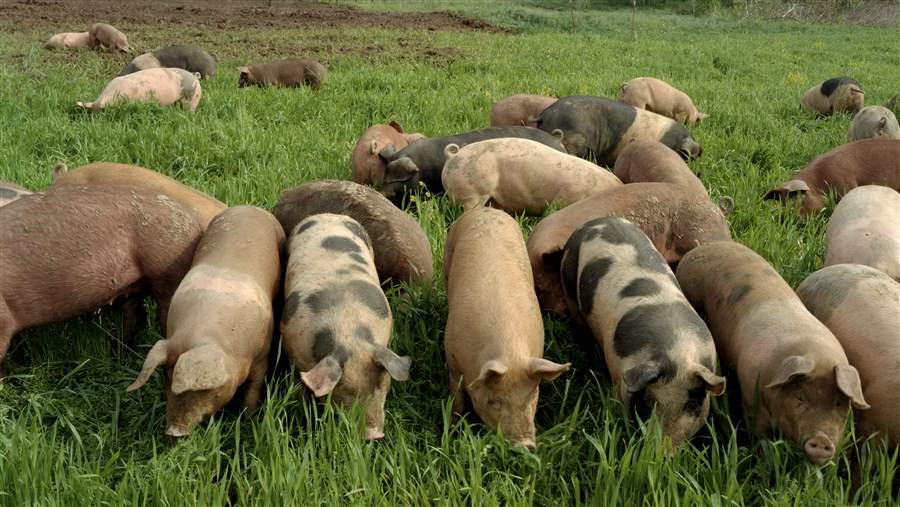What Percent Of Antibiotics Are Given To Animals
Antibiotics and Animal Agronomics: A Primer
Why are antibiotics used in animal agronomics, and what tin can be washed to ensure their appropriate apply?

Getty Images
This fact sheet was updated in Feb 2018 to reflect the release of 2016 FDA sales information.
Overview
Each twelvemonth, at to the lowest degree 23,000 Americans die and some 2 million are sickened from antibody-resistant bacterial infections.one Antibiotics are crucial to the health of people and animals, but whatever use endangers their efficacy, as leaner develop resistance to them over time. Therefore, to preserve these lifesaving drugs, antibiotics should be used as fiddling equally possible in all settings—including in health care and agriculture—and just when medically necessary and advisable.
Antibiotics used in animal agriculture contribute to the threat of drug resistance. Although detailed information about antibiotic employ in animals is lacking, available data show that around 70 percent of the total volume of all medically important antibiotics in the United States is sold for use on the farm.2 This is currently the but available data for tracking and assessing antibiotic use in U.S. animal agriculture, merely it is inadequate.
Antibody use by the numbers
In 2016, data reported to the U.S. Food and Drug Administration showed that the sale of medically of import antibiotics had declined xiv percent overall from 2015 to 2016, the first decrease since these data were initially reported in 2009. Information technology besides was the start time that animal drug companies have cleaved down sales estimates past the major types of food animals—pigs, cows, chickens, and turkeys—setting a baseline for species-specific sales data in the years to come and shedding lite on the unlike antibiotic use patterns beyond these species.3 The data likewise revealed that:
- About 95 percent of the antibiotics were sold for use in feed and water, which makes tailoring treatments to individual animals difficult.4
- Almost 96 percent were sold over the counter, without any veterinary oversight or involvement, but an FDA policy, discussed below, has since changed that—for the most part.five

Getty Images
How the regime is addressing the problem
In 2013, FDA took an important pace toward ensuring the judicious use of medically of import antibiotics by finalizing a policy, known as Guidance for Industry #213, that prohibits the utilise of medically important antibiotics for production purposes (i.e., given to healthy animals to promote growth and enhance feed efficiency). Nether this policy, which was fully implemented in January 2017, any add-on of antibiotics to feed and h2o requires the oversight of a veterinarian. In improver, the Veterinary Feed Directive, a companion policy issued in 2015, outlines the weather condition nether which veterinarians can authorize antibiotic utilise in animal feed and the accompanying responsibilities veterinarians must presume.
With total implementation of these ii policies, inappropriate antibody use should decrease and the veterinary oversight of medically important antibiotics should increment dramatically. Even so, better antibiotic use data are needed to assess the impact of these policies.
Essential side by side steps
1. Collect and report better information.
Only limited information is currently bachelor on why antibiotics are used in nutrient animal product, particularly whether it is for the handling of disease or to prevent and control its spread. FDA, together with the U.S. Section of Agronomics and the Centers for Disease Control and Prevention, has outlined a draft program for collecting additional data on farm-level antibiotic use and resistance that depends on close collaboration past the iii agencies and draws upon existing information drove systems. The goal is to expand and amend integrate existing and potential new data sources to provide a comprehensive picture of antibody utilize practices in animal agriculture and their links to resistance. If adequate funding is fabricated available, this information would underpin efforts to understand the effects of policy change and ready future priorities. FDA already collects aggregate data on total antibiotic sales from veterinarian drug companies. In May 2016, the bureau moved to enhance these data by requiring beast drug companies to estimate the amount of antibiotics sold for use in pigs, cows, chickens, and turkeys to improve agreement of antibiotic utilise and differences beyond the major food animate being species.
ii. Refine antibody labels.
FDA and others have noted the potential for connected injudicious antibiotic utilise even after the Jan 2017 implementation of Guidance #213. A Pew analysis demonstrated that more than 1 in 3 antibiotic labels volition still non fully meet judicious use guidelines. In particular, some drugs volition remain on the market with approvals for continuous assistants or utilise for undefined durations, and others are not targeted toward a specific animal disease. Some drugs lack a defined dosage or have an exceedingly wide dosage range, which raises questions about what dose is advisable. None of this is consistent with judicious use principles. FDA should work with drug companies and other stakeholders to accost these concerns by reviewing and revising these problematic labels.
3. Minimize the need for antibiotics through the increased utilize of alternative products and practices.
How animals are housed, fed, and raised affects their wellness and thus the demand for antibiotics. Improving animal husbandry practices—such as the age at which pigs are weaned or the type of floor used in brute areas—and adopting culling interventions, such as vaccines, probiotics, or prebiotics, can reduce the gamble of disease. The agronomical sector should research, develop, and prefer husbandry practices and alternative interventions that reduce the demand for routine antibiotics.
4. Buy meat raised according to responsible antibiotic use guidelines.
Consumers tin influence food producers by purchasing meat and poultry that was raised responsibly. Parents and patients tin can request that schools and hospitals offer these types of proteins too. USDA-verified labels can assistance ensure the transparency and accountability of production practices.
Endnotes
- Centers for Disease Command and Prevention, Antibody Resistance Threats in the United States, 2013 (2013), http://www.cdc.gov/drugresistance/threat-report-2013.
- U.South. Food and Drug Administration, 2014 Summary Report on Antimicrobials Sold or Distributed for Utilize in Food-Producing Animals (2015), http://www.fda.gov/downloads/ForIndustry/UserFees/ AnimalDrugUserFeeActADUFA/UCM476258.pdf. Data on antibacterial drugs used on humans in the U.S., 2011-14, are from IMS Health (now QuintilesIMS), obtained April 12, 2016. The full volume of medically of import antibiotics sold for use in food animals based on 2014 FDA data was xx,890,979.vii pounds. The full volume of antibiotics sold for apply in humans based on IMS calculations was vii,704,435.8 pounds.
- U.Due south. Food and Drug Assistants, 2016 Summary Written report on Antimicrobials Sold or Distributed for Employ in Food-Producing Animals (2017), https://www.fda.gov/downloads/ForIndustry/UserFees/ AnimalDrugUserFeeActADUFA/UCM588085.pdf.
- Ibid.
- Ibid. Medically of import antibiotics that are non administered through feed or water were not affected by Guidance #213, and some of these products (eastward.g., injectable products) may however exist available over the counter.
Additional RESOURCES
More than FROM PEW
Source: https://www.pewtrusts.org/en/research-and-analysis/fact-sheets/2016/12/antibiotics-and-animal-agriculture-a-primer
Posted by: mcdonoughonink1956.blogspot.com

0 Response to "What Percent Of Antibiotics Are Given To Animals"
Post a Comment